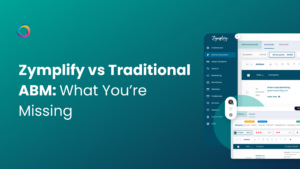Intent data is a crucial tool for businesses looking to identify the behaviours, interests, and priorities of prospects, and then engage them at the right moment with the right message.
However, relying on a single source of intent data often results in incomplete insights and missed opportunities. This is where layering intent data comes into play. By combining signals from multiple sources, businesses can create a multi-dimensional view of prospects, improving accuracy, relevance, and conversion rates.
Why Layering Intent Data is Essential for Your Strategy
Layering intent data is essential because no single source can capture the full complexity of a buyer’s journey. By integrating data from first, second, and third-party sources, businesses can gain a richer, more actionable understanding of their target audience.
This amplifies the power of your data by validating and cross-referencing signals. For instance, layering G2 activity with website visits or combining download data with hiring signals helps confirm genuine intent to enable smarter prioritisation of leads. With a layered approach, marketing and sales teams gain a clearer understanding of where prospects are in their buying journey, allowing for more accurate pipeline forecasting and strategic planning.

The Core Layers of Intent Data
Layering intent data begins with understanding the unique value of each type of data available.
First-Party Data
First-party data includes information gathered from your owned channels, such as:
- Website Traffic: Using tools like IP tracking, businesses can identify companies visiting their site, even if they don’t fill out a form.
- Content Engagement: Downloads of case studies or whitepapers signal deeper interest and potential readiness to buy.
- Email Interactions: Opens and clicks reveal which prospects are engaging with your campaigns.
This layer provides direct insights into how prospects interact with your brand and is often the starting point for layering intent data.
Second-Party Data
Second-party data comes from platforms like G2 or partnerships with review sites and industry-specific platforms. The key signals include:
- Competitor Comparisons: Monitoring G2 activity shows when prospects are evaluating your competitors.
- Alternative Searches: Identifying searches for similar products or solutions can highlight early buying intent.
- Engagement with Industry Content: Activity on niche platforms reveals interest in your sector.
This data complements your first-party insights by adding external context, helping you understand how prospects view your offering within the competitive landscape.
Third-Party Data
Third-party data reveals broader buyer trends. The key signals to monitor include:
- Topic Intent: Monitoring consumption of industry-specific content helps identify prospects at the research stage.
- Hiring Signals: Companies expanding their teams in key roles may signal readiness to adopt new solutions.
- Event Participation: Attendance at trade shows or webinars often indicates active interest in industry advancements.
This layer is particularly valuable for identifying early-stage prospects and staying ahead of emerging trends.
How to Layer Multiple Intent Data Sources Effectively
To make the most of layered intent data, businesses need a clear framework for gathering, validating, and activating these signals. With data coming from various channels, a clear process can align these signals into a unified view of prospects.
1. Gather Data from Diverse Channels
Start by collecting data from various sources, including your CRM, marketing platforms, and third-party providers. Ensure your tools are integrated to streamline data analysis.
2. Validate and Combine Signals
Layering works best when signals from different sources are cross-referenced. For example, a prospect showing interest on G2 and downloading a whitepaper from your website is more likely to be in-market than one displaying just one of these behaviours.
3. Segment and Prioritise Leads
Use layered intent data to categorise leads into high, medium, and low priority based on the strength and number of intent signals. Focus your outreach on accounts with multiple high-value signals.
4. Activate Data Across Campaigns
Incorporate layered intent insights into your ABM campaigns, sales workflows, and content strategies to ensure every touchpoint is highly relevant and impactful.
How Zymplify Can Help to Extract More Value from Layered Intent Data
Our Buyer Intent Activation and Intelligence platform simplifies the complex process of layering intent data by bringing multiple sources into one intuitive platform. Instead of juggling disparate tools and data streams, Zymplify provides a unified system that integrates first, second, and third-party signals seamlessly.
- Real-Time Signal Validation: Zymplify cross-references signals from various sources to confirm genuine intent, ensuring your team focuses on the most promising leads.
- Customised Campaign Activation: With layered insights at your fingertips, Zymplify enables you to personalise outreach, refine targeting, and enhance ABM strategies effortlessly.
- Streamlined Workflows: From data collection to activation, Zymplify automates the process, freeing your team to focus on high-impact activities instead of manual data management.
With Zymplify, businesses can leverage the power of layered intent data to engage prospects more effectively and close deals faster.
Take the Guesswork Out of Engagement with Layered Intent Data
Layering multiple sources of intent data is crucial for better understanding and engaging today’s complex buyer journeys. By combining first-, second-, and third-party insights, you can create a complete picture of prospects and take informed actions that drive results.
Curious about how to leverage layered intent data for your business? Book a demo with our team today to see how Zymplify can streamline your processes, improve targeting, and boost conversion rates.




